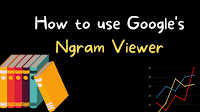
06 Aug Add Google’s Ngram Viewer to Your List of Research Tools
Google’s Ngram Viewer is a search tool that students can use to explore the use of words and names in books published between 1800 and 2019. The Ngram Viewer shows users a graph illustrating the first appearance of a word or name in literature and the frequency with which that word or name appears in literature since 1800. The graph is based on the books and periodicals that are indexed in Google Books.
The Ngram Viewer will let you compare the use of multiple words or names in one graph. The example that I give in this video is to compare the use of the terms “National Parks,” “National Forests,” and “National Forest Service.” By looking at the Ngram Viewer for those terms I can see that they start to appear more frequently around 1890, have a lull in the 1940s and 1950s, and then appear more frequently again in the 1960s.
Ngram Viewer is based on books indexed in Google Books. That is why below every graph generated by Ngram Viewer you will find a list of books about each of your search terms. Those books are arranged by date.
A third component of Ngram Viewer to note is that it works with multiple languages including English, French, Chinese, German, Italian, Russian, Hebrew, and Spanish.
Applications for Education
As I mentioned in the video above, the Ngram Viewer can provide a good way to start a research activity for students. Have them enter a few words then examine the graph to identify peaks and valleys in the frequency of the words’ usage. Then ask them to try to determine what would have caused those words to be used more or less frequently at different periods in history.
Google’s Ngram Viewer is a search tool that students can use to explore the use of words and names in books published between 1800 and 2019. The Ngram Viewer shows users a graph illustrating the first appearance of a word or name in literature and the frequency with which that word or name appears in literature since 1800. The graph is based on the books and periodicals that are indexed in Google Books.The Ngram Viewer will let you compare the use of multiple words or names in one graph. The example that I give in this video is to compare the use of the terms “National Parks,” “National Forests,” and “National Forest Service.” By looking at the Ngram Viewer for those terms I can see that they start to appear more frequently around 1890, have a lull in the 1940s and 1950s, and then appear more frequently again in the 1960s. Ngram Viewer is based on books indexed in Google Books. That is why below every graph generated by Ngram Viewer you will find a list of books about each of your search terms. Those books are arranged by date. A third component of Ngram Viewer to note is that it works with multiple languages including English, French, Chinese, German, Italian, Russian, Hebrew, and Spanish. Applications for Education As I mentioned in the video above, the Ngram Viewer can provide a good way to start a research activity for students. Have them enter a few words then examine the graph to identify peaks and valleys in the frequency of the words’ usage. Then ask them to try to determine what would have caused those words to be used more or less frequently at different periods in history. By the way, the book that I mentioned in the video is That Wild Country by Mark Kenyon.  Free Technology For Teachers, google books, how to, Ngram Viewer, Research, Research Tips, search strategiesRead More
Free Technology For Teachers, google books, how to, Ngram Viewer, Research, Research Tips, search strategiesRead More


Sorry, the comment form is closed at this time.